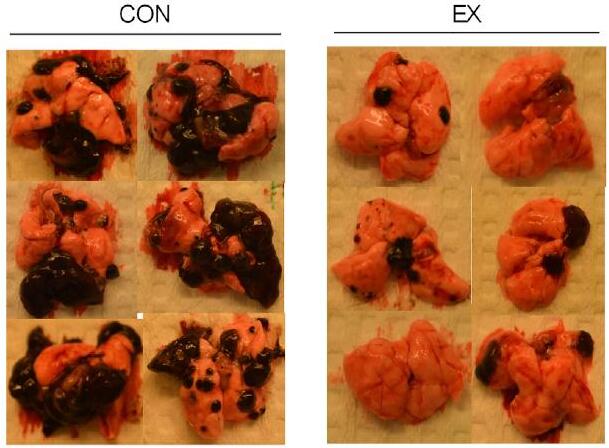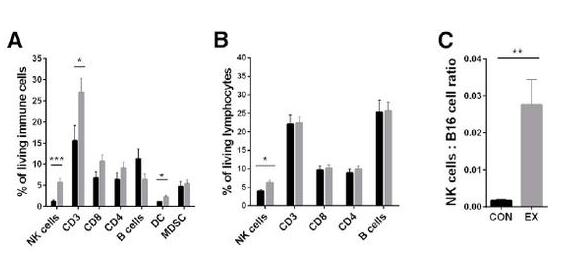
It is undeniable that some cancer patients are not fit forexercise. However, most of the clinical researches in the past have shown that regular exercise can boost patient’s aerobic fitness, that is cardio-pulmonary function and build up the muscle health in that many patients suffer from muscle fatigue and muscle weakness. It also contributes to the patient’s psychological adjustment and the stability of endocrine environment.
Broadly speaking, exercise can bring benefits to normal people; it could bring benefits to cancer patient as well.
You might say that the above-mentioned statement is a universal law that everybody realizes. Today, we are going to introduce to you a new finding-exercise can shrink tumor directly.
Nature has reported the findings published on Cell. The research is jointly participated by teams from Denmark, Sweden, Germany and America.
In the randomized controlled experiment, researchers designed different research models for liver cancer, melanoma, and lung cancer.
In the research of melanoma, researchers have mice do running four weeks prior to tumor cell inoculation, after which the mice was made to run for another two weeks. As a result, the incidence rate of melanoma of wheel running mice reduced by 60% compared to that of non-exercise mice. The tumor volume of adult female mice and old female mice reduced by 67% and 53% respectively compared with that of control group. Exercise also played a remarkable role in terms of the lung metastases of melanoma. Please refer to Figure 2.

Figure 2. Representative pictures of melanoma with lung metastases in mice after i.v. Injection. The left pictures are the lungs of the control group while the right ones are the lungs of wheel running mice. Lung tumor of control group is far bigger than that of wheel running mice both in terms of volume and number.
After 4-week-old male mice are injected with DEN (liver cancer is expected to develop within 10 months), researchers found that the incidence rate of liver cancer in wheel running mice is about 31% while the incidence rate liver cancer of control group is up to 75%. The volume of wheel running mice is also significantly smaller than that of control group.
In the model of lung cancer, 58% decrease of lung tumor volume and 56% decrease of lung tumor weight are seen in wheel running mice compared with that of control group.
Researchers did another experiment on melanoma. They found that exercise can delay the progression of malignant lesions in transgenic mice that can develop melanoma.
The average wheel running distance was 4.1km/mouse/day.
Why is that?
One cannot help but be curious about the reason behind the experimental result.
Researchers found out that reduction in tumor growth is associated with induction of immune-related pathways. Relevant test showed that the the immune system activity in wheel running mice is higher than that of control group.
Then they noticed a key point between the immune system and reduction in tumor growth, that is the frequencies of NK cells in tumor. Though immune cell activity caused by exercise vary in different cancer models and different mice, researchers found, after many studies and comparisons, that despite of the regulation of other cell and cytokins, NK cell showed the same response in different models--there is a stark contrast of the NK cell frequencies in tumor between wheel running mice and control group.

Figure 3. Histological analysis of of tumor sections stained for NK 1.1 or CD 8 in bed. The left represent the control group while the right represent wheel running group. The red-stainted cells are NK cells. In control group, the frequency of NK cell is too low to be seen. However, in wheel running group, frequency of NK cell increase significantly.

Figure 4. Data from different experimental models. The black column represents control group and the grey column represents the experimental group. In different models, the frequency of NK cell in the experimental group is higher than that in control group.
Seeing the above experimental result, you might wonder if it is exercise that has increased the frequency of NK cell. Well, yes and no.
It is true that researchers found that the frequency of NK cell will increase in bone marrow, spleen and peripherial blood in tumor-free mice if it keeps doing exercise like that in the control group.
However, regular exercise did not enable any frequency increase of NK cells in these parts of the mice but only in the tumor. Isn’t it strange?
After analysis, researchers believed that the accumulation of NK cells in tumor is made through β-epinephrine signal pathway. They speculated that the role that exercise plays in the process is to create the environment for a unblocked pathway. That is exercise can enable NK cell to enter tumor and kill tumor cells in a faster and efficient manner.
It’s not hard to see that exercise has shown strong killing effect on the multiple tumors involved in the experiment. Researches in the past have also shown that exercise can also improve patients’ prognosis in the clinical trials on breast cancer and prostate cancer. It is for sure that exercise should be done at moderate level. The appropriate intensity of exercise for cancer patients should be decided by the doctor in charge.
Healthy people have every reason to get off your butt and get active seeing the above-mentioned experiment that exercise can delay the progression of malignant tumor even if you are being injected with high-risk cancerogen.
Reference
1. Pedersenetal.,VoluntaryRunningSuppressesTumorGrowththroughEpinephrine-andIL-6-DependentNKCellMobilizationandRedistribution,CellMetabolism(2016),http://dx.doi.org/10.1016/j.cmet.2016.01.011
2. ComprPhysiol.2012October;2(4):2775–2809.doi:10.1002/cphy.c120005
3. LeeW.Jones&CatherineM.Alfano(2013)Exercise-oncologyresearch:Past,present,andfuture,ActaOncologica,52:2,195-215,DOI:10.3109/0284186X.2012.742564
4. AnnalsofOncology25:947–958,2014doi:10.1093/annonc/mdt551